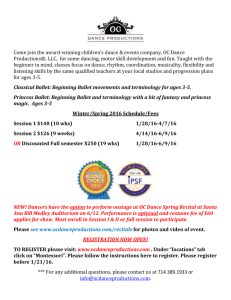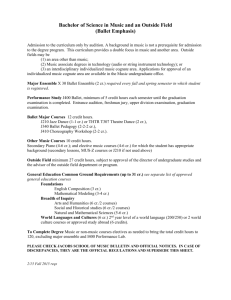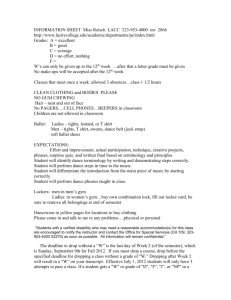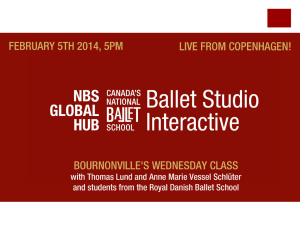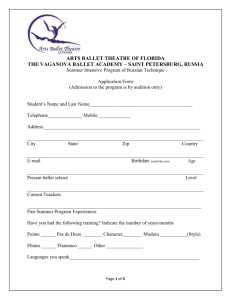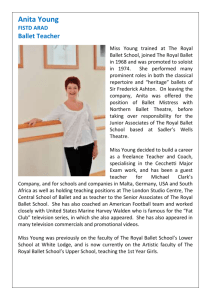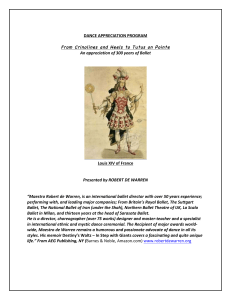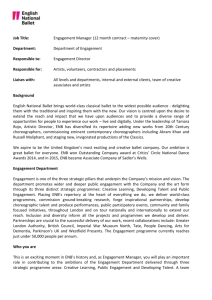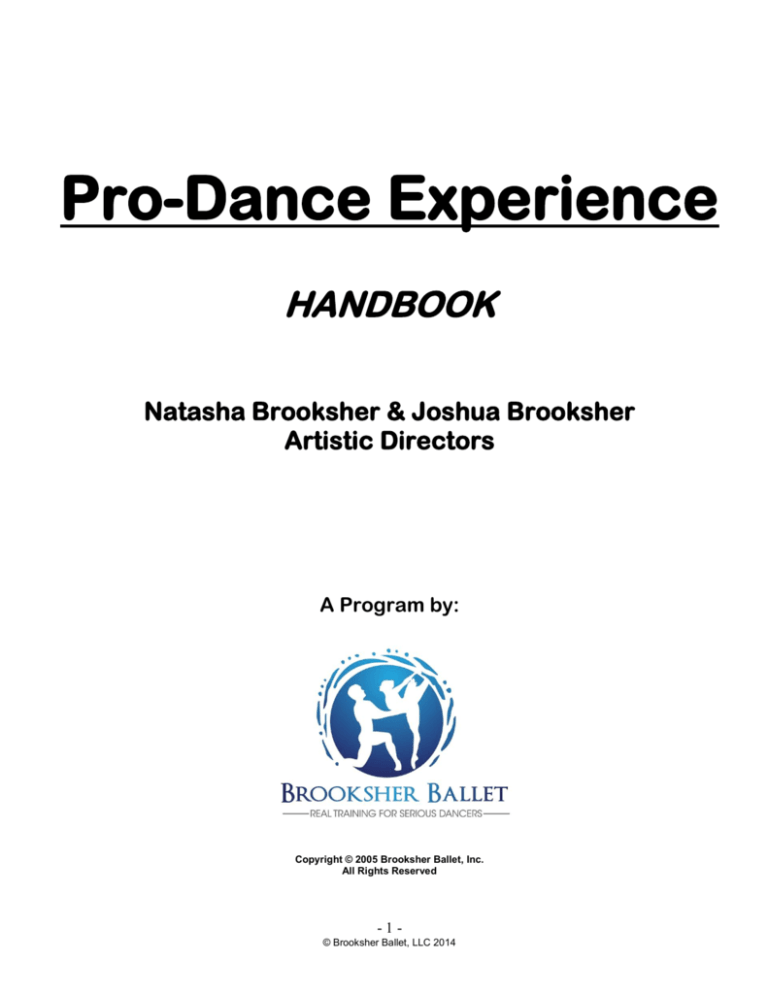
Pro-Dance Experience
HANDBOOK
Natasha Brooksher & Joshua Brooksher
Artistic Directors
A Program by:
Copyright © 2005 Brooksher Ballet, Inc.
All Rights Reserved
-1© Brooksher Ballet, LLC 2014
Table of Contents
Our Philosophy
Class Placement
Class Schedule
Attendance
Code of Conduct
Disciplinary Policies
Dress Code
Class Etiquette
Ballet Bag/Locker Contents
-2© Brooksher Ballet, LLC 2014
Philosophy
Brooksher Ballet’s Pro-Dance Experience prepares gifted students from to become the next generation of classically trained
ballet dancers. The program provides students with the opportunity to study with outstanding ballet professionals, who bring
both practical experience and teaching ability to their classes.
Ballet is one of the most complex art forms, with many aspects incorporated into the training of a well-rounded dancer.
Expression, artistry, and the nuances of style in classical ballet, as well as the basic technique, are difficult to learn.
Students must have both natural gifts and the physical characteristics conducive to the training, as well as a certain
professionalism and dedication.
We also view the training of a dancer as the development of a person as a whole. One of the most basic principles behind
the technique is to give of yourself: to your training, your teachers, your classmates, your audience, and most of all your
community.
“Any arts or creative profession educates or cultivates people, not only the professional aspect but the personality; it
cultivates the individuality of the person. In particular, the arts and ballet cultivate the intellect as well as a person’s
behavior, mannerisms, self-discipline—all of these things are developed through the arts. Without possessing this
multiplicity of qualities that are cultivated by the arts, a person cannot really go out on the stage and really represent the art.
He or she has to be a well-rounded, fully developed individual.” ---Mme Yelena Vinogradova
The kind of training we provide, and that we ourselves were schooled in and excelled with, is based on the Vaganova
Methodology of ballet training. This pedagogical system originated at the prestigious Vaganova Choreographic Institute in
St. Petersburg, Russia, and is carried on seriously in the United States in only a handful of other schools. This system of
training has been perfected over many years of intense study in conjunction with the choreography of Marius Petipa, the
“grandfather” of the classical style, has successfully produced some of the greatest dancers of all time: Anna Pavlova,
Natalia Makarova, Rudolph Nureyev and Mikhail Baryshnikov are among them.
We intend to continue the tradition of passing on the art of ballet from our own training and performing experience to the
next generation of dancers. The process of training a dancer from the beginning stages through to becoming an artist
normally takes between six and eight years, starting at the age of ten and continuing with daily study through the age of
eighteen. The format the classes are based on takes 90 minutes to complete: about 30 minutes of barre, 30 minutes of
center, and about 30 minutes of jumping. This is of course a basic idea, as each class will be specifically tailored to the
abilities and needs of the students in the class. There is a specific order in which exercises are executed to maximize the
correct development of each group of muscles, warm them up properly, and create flexibility, strength and control.
Students will be expected to learn the names, spellings, definitions, and proper execution of all movements presented in
class, and how they relate to the overall structure of a training class. Students will learn to really think about what they are
doing and why and how the movements coordinate with each other to present a unified picture. This is broken down into
aesthetic, technical and philosophical reasons. Most dancers trained in the West dance mainly with raw emotion without
emphasis on placement, structure and technique to back it up. The Vaganova method provides a sound structure through
which to express that emotion with more clarity. Here at BB we want our students to be knowledgeable about what they do,
to think about things before they do them. “All children are artists. The challenge is to remain an artist as they grow up.”
Along with regular ballet, and (for those who are ready) pointe classes, we will make available more contemporary forms of
movement. A variety of classes contributes to the development of a well-rounded dancer as long as technique is not set
aside. Professional companies in America today demand proficiency not only in classical ballet, but also in the ability to
move in more contemporary styles as well.
A great deal of strength, endurance and dedication is required to be a dancer. The intensity of the program, the number of
classes, and the strict and precise demand on the body of the dancer, requires that students and their families make a high
investment level of time, energy, and resources. We strongly believe that in the long run it is worth the effort. Through this
method of training in the art of ballet, we endeavor to cultivate the body, mind and spirit to its fullest potential.
-3© Brooksher Ballet, LLC 2014
Location / Drop Off & Pick Up
All Brooksher Ballet Pro-Dance Experience classes will be held at:
Arizona State University Herberger Institute for Design and the Arts
611 East Orange Street, Tempe AZ 85287
Physical Education Building West Rooms 239 & 240.
All students must sign in with the volunteer registrar at the beginning of the day and sign out before leaving at the end of the
day. Parents may drop off/pick up their children on the North entrance to the PE West Building just off of Orange Street.
PEBW 239 and PEBW 240 are located on the second floor on the east side of the building which is just two buildings west
of the ASU Bookstore and just east of the Memorial Union on the west side of the Palm Walk and south side of Orange St.
We recommend parking in PS-1 just off of Apache Blvd. to escort students to PEBW. Additional parking is indicated in the
numbered areas on the map below. For more ASU Tempe Campus parking information visit www.asu.edu.
-4© Brooksher Ballet, LLC 2014
Class Placement
Level/Grade Assignments
Placement classes will be held on the first day of the program. Students will be assigned a level based on ability, desire,
work ethic, and proficiency. We ask that students adhere to the levels and classes assigned to them. Dancers are not
allowed to take classes of levels above their assignment, unless given permission by the Directors.
Neither a dancer’s age, nor their previous class placement guarantees them an assignment to a particular level.
Class Schedule
Finalized class and daily activity schedules will be posted outside of each dance room / studio at the beginning of each day.
Each students’ school day will begin at 9am and end at 3pm.
Students will be escorted to the nearby Memorial Union for a one-hour lunch break. Food is available for purchase;
however, students are encouraged to bring a healthy sack lunch from home that does not require refrigeration or reheating.
More information on services provided at the Memorial Union is available at www.asu.edu.
Attendance
All classes are mandatory unless otherwise noted.
Absences/Attendance Policies
Any absence due to illness etc. MUST be phoned in or emailed and excused prior to the start of class BY THE
STUDENT’S PARENT OR GAURDIAN.
A limited number of absences are allowed: 2 excused and 1 unexcused, before a student’s placement and participation
in performance or demonstrations may be reconsidered.
Students too injured to dance must watch class and take notes unless excused to stay on bed rest by a note from a
nurse/doctor. Any appointments needed for doctor’s visits, physical therapy, chiropractor, etc. to rehabilitate an injury
take precedence over class attendance. Please notify the Directors of your appointments ahead of time. Soreness is
NOT an excusable absence: all the more reason to get in the studio and move around. Dancers will feel much less
sore by coming in to class and dancing.
If a dancer must be excused early from class, please notify the Directors ahead of time. Please approach the teacher of
the class the dancer needs to be excused from at the beginning of class.
If a dancer is absent from or does not take their ballet technique class, for whatever reason (sickness, injury, tardiness) they
will not be allowed to participate in their other classes. Dancers may participate in Pointe, Partnering and Repertoire classes
ONLY in their own level, and ONLY if they have already had Ballet Technique that day.
-5© Brooksher Ballet, LLC 2014
Code of Conduct
Brooksher Ballet is dedicated to creating an environment of artistic and academic excellence so that students may flourish
as young artists and individuals. BB insists upon the observance of the highest moral and ethical standards by its staff and
students. Each student, as well as the parent or guardian of any student younger than eighteen, must agree to the following
“Code of Conduct”:
To further this objective, the Institute provides a community that fosters its students’ well-being, safety and a healthy social
environment.
Our student body represents various nationalities, cultures, religions, races, and age groups. This diversity makes it
incumbent upon the Institute to hold our community accountable to a coherent set of standards of conduct and behavior.
Beyond respectful, courteous, mature, and ethical behavior, the Institute also insists upon the observance of the highest
moral standards by its staff and students. As the ages of our students range from 10 years upward, our conduct must
particularly suit the needs of our youngest students.
The Institute expects of its older students conduct that projects positive and wholesome models on the young, both on and
off campus. Use of cigarettes, alcohol, or illicit drugs or sexually permissive and promiscuous behavior will not be tolerated.
The following rules are the most essential and must be specifically addressed in our common interest:
1. To maintain placement, a student must demonstrate satisfactory artistic progress and exhibit the physical and mental
requisites for further successful training.
2. Prompt attendance at classes, conferences, and assemblies is required.
3. Respectful, courteous, and friendly treatment towards Institute staff, classmates, and visitors is necessary at all times.
4. Any behavior that compromises the good name of Brooksher Ballet is unacceptable.
5. Students are expected to choose their dress within generally accepted norms of good taste and respectability.
6. Students may not be in any dance room / studio without the supervision of BB faculty or staff.
7. Students may not smoke at any time.
8. Students may not possess, use or distribute illicit drugs, on or off campus. Students ages 21 and over may not
consume alcohol on campus or distribute alcohol to minors on or off campus.
9. Given cause, the Institute reserves the right to require drug testing, and the parents and students hereby agree to such
testing. Refusal to submit to drug testing on the occasion the Institute determines it necessary is grounds for dismissal.
10. The Institute reserves the right to search dorm rooms and any other places or articles on school premises. Items
prohibited by law or by school regulations will be removed.
11. Areas restricted to staff, such as the employee lounge, utility, storage, and maintenance facilities, are off limits to
students. Tampering with fire alarms or other safety equipment is prohibited.
12. No incendiary materials, knives, or weapons are allowed.
13. Students are obligated to uphold the “Code of Conduct” and any additional rules and regulations established by the
Institute following their admission.
-6© Brooksher Ballet, LLC 2014
Brooksher Ballet may dismiss any student for any reason it deems appropriate. Maintenance of student status at the
Institute is contingent upon, but not limited to, the students continued satisfactory artistic suitability as well as observance of
the “Code of Conduct” and any other additional rules and regulations established by the Institute at or following admission.
Parents and students are expected to have read the “Code of Conduct”, and to recognize and acknowledge that its
provisions shall be binding on the parent or guardian and the student while the student is enrolled or participates in any BB
program.
Disciplinary Policies
All students must observe the Code of Conduct, the rules, regulations and policies governing student behavior at
Brooksher Ballet’s Pro-Dance Experience as printed in the current edition of the “Student Handbook”. The Institute
at its sole discretion may add to, amend, suspend or delete any provisions of the Code of Conduct or the supplemental
rules, regulations and policies which govern student life.
A single violation of any part of the Code of Conduct or any one of the rules, regulations or policies of the Institute may
result in one or more of the following disciplinary actions:
Restrictions: Certain violations may entail the loss of student privileges. Restrictions might include the loss of
recreational privileges or exclusion from activities.
Official Warning: An official warning is a written record of a violation. A copy of the warning is given to the student
and a copy is placed in the student’s file. If a student receives a second warning, a copy of it will be sent to the
parent or guardian of the student who is under the age of 18. The Institute will also inform the parent or guardian of
the nature and seriousness of the violation. Receipt of a second written warning constitutes probationary status.
Probation: A student on disciplinary probation is subject to immediate suspension or dismissal from the Institute
for any additional violations. The length of probation is determined by the Directors. If a student is on probation
and commits a further violation, any faculty member or Residential Assistant may recommend to the Directors that
the student be suspended or dismissed completely.
Suspension: A student may be suspended from the Institute for the remainder of his or her current term. A
student who has been suspended may apply for re-admission for any following term.
Dismissal: A student is dismissed from the Institute for an indefinite period of time. A student who has been
dismissed must receive written permission from the Institute before making application for re-admission.
Upon evaluation of the seriousness of a violation, the Directors may decide to issue an official warning, assign restrictions,
place a student on probation or consider additional disciplinary action. The Directors decide the appropriate form of
discipline, suspension or dismissal on a case by case basis. Students under review for a violation will be required to appear
before the Directors. The Directors will render their decisions in private and report their decisions in writing to the parties
involved.
There are NO REFUNDS for any student incurring such violations that result in restrictions, suspension or dismissal.
-7© Brooksher Ballet, LLC 2014
Dress Code
Adherence to Dress Code is mandatory. One verbal warning and one written warning will be issued before a
student will not be allowed to participate in class (incurring an unexcused absence).
LADIES
Leotard: black spaghetti, tank or cap sleeve only (no multiple or criss-cross straps)
Undergarments to be either flesh toned or black (no bra straps please)
Full footed/convertible ballet pink tights worn under
leotards and inside shoes
Pink canvas split-sole shoes
Pointe shoe ribbons sewn on all shoes including flat shoes (no elastic)
Hair off the face in a secure bun
A small wrap ballet skirt OK for pointe, variations and rehearsals
No skirts in technique class
No jewelry in class or rehearsals (dangly earrings, watches, bracelets, big rings, necklaces)
Light makeup for students over 13 years old is acceptable.
Appropriate character shoes and character skirts to be worn for character and flamenco classes.
GENTLEMEN
Dance belt must be worn
White tight fitting t-shirt
Black millskin tights (with elastic suspenders under t-shirt) or unitards (Baltogs or M. Stevens)
Footed tights/unitards to be worn with black shoes
Footless tights/unitards to be worn with white socks and white shoes
Criss-crossed elastics sewn on to shoes
Black jazz shoes to be worn for character classes.
Class Etiquette
Adherence to Class Etiquette is mandatory. One verbal warning will be issued before a student will be excused
from class because of disruptive or disrespectful behavior. A positive, respectful and serious working environment is
vital to each student’s success.
Arrive early to prepare yourself for class/rehearsal
Prepare the studio for class
Be standing, spaced at the barre, and ready to dance when the instructor enters the room (stop talking)
Not more than ten minutes late to class, otherwise you must watch and take notes
Must ask permission of the teacher to join the class if you are late
Join between exercises, not during an exercise if you are late
Must ask permission to leave class
No sitting at all during class unless instructed to do so
-8©Brooksher Ballet, Inc. 2003
Do not run across the front of the studio when others are dancing. Go to the sides & around the back of the
studio.
When your group is not dancing, figure out the exercise on the other side, the reverse, make sure you know
the combination.
No dress code/shoe code means no class. You will be required to watch and take notes
Raise your hand to ask a question
NO TALKING
NO GUM
Applaud at the end of class to say thank you.
For a guest teacher---present yourself to them at the end of class to say thank you with a handshake or
curtsey.
No running or yelling in the hallways, and politeness and courtesy outside of the studio is expected.
Pick up after yourselves in the dressing rooms, green room, bathrooms and hallways at all times, both at the
studio, and at the dormitory facilities.
Ballet Bag Contents
BOYS
GIRLS
Extra tight fitting plain white t-shirt
Extra tights/shorts (black) [see dress code]
Extra dance belt
Ballet shoes
Legwarmers/sweatpants
Sweatshirt/jacket
Slippers
Water bottle
Hand towel
Deodorant
Dance text books (see Reading List at the end of the Handbook)
Dance notebook/pen
Sewing kit
o Needles
o Small pair of scissors
o Black and white thread
Extra leotard
Extra pink tights (no holes)
Sewn ballet shoes
Sewn pointe shoes
Warm-ups, sweatpants
Sweatshirt/jacket
Slippers
-9©Brooksher Ballet, Inc. 2003
Dance text books (see Reading List at the end of the Handbook)
Dance notebook/pen
Sewing/Pointe shoe kit
o Needles
o Scissors
o Matches
o Black, white, pink thread
o Extra ribbons
o Extra elastics
o Molefoam
o Pliers
o Heavy duty scissors
o Tape
Hair kit
o Spray water bottle
o Hair spray/gel
o Brush
o Hair elastics
o Hair nets
o Bobby pins
o Hair pins
o Scrunchy, flowers, ribbons and other small decoration
Foot/Medical kit
o Nail Clippers
o Nail File
o Bandaids
o Alcohol, peroxide, iodine
o 2nd skin, NewSkin
o Athletic tape
o Athletic pre-wrap
o Ace bandage
o Instant ice pack
o Mineral Ice, Tiger Balm
o Foot Roller
o Theraband
o Ibuprofen
o Preparation H, Oragel
o Corn, bunion pads
o Extra toe pads
o Scissors
o Sterile gauze, cotton
Personal hygiene
o Deodorant
o Baby powder
o Tampons
o Hand towel
- 10 ©Brooksher Ballet, Inc. 2003


